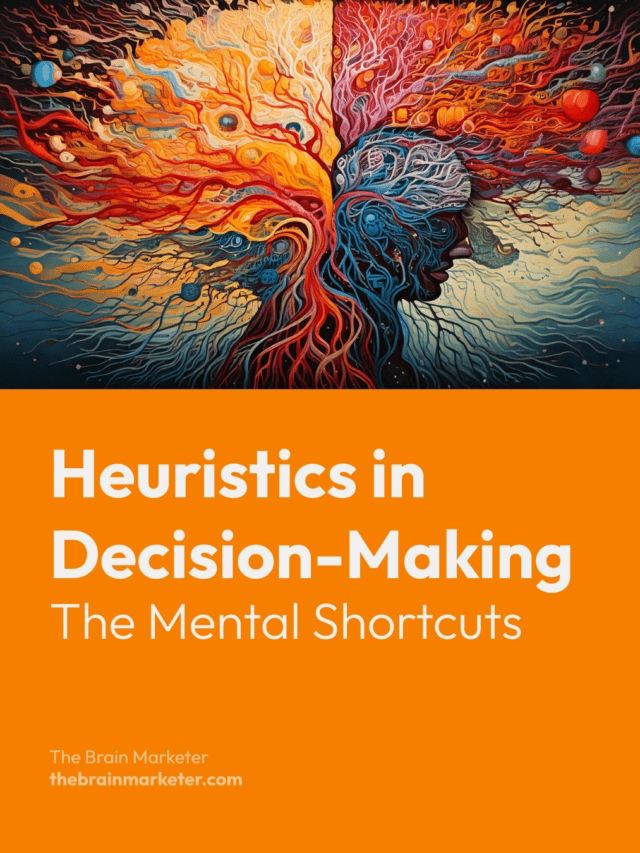Every day, we make thousands of decisions — some conscious, others automatic. Many of these choices are guided by mental shortcuts, known as heuristics. These cognitive shortcuts help us process information quickly, but they can also lead to biases and errors. Understanding heuristics is essential for marketers, as they shape consumer behavior, decision-making and brand perception.
In this article, we’ll explore how they work, their impact on decision-making and how marketers can use them ethically to influence consumer choices.
Key Takeaways
- Heuristics are mental shortcuts that help people make quick decisions but can lead to biases.
- Tversky and Kahneman identified key heuristics like representativeness, availability, anchoring and affect.
- Marketers leverage heuristics to shape consumer perception, pricing strategies and emotional connections.
- Understanding heuristics can improve marketing by aligning strategies with how people naturally think.
- Ethical considerations are crucial, heuristics should not be exploited to manipulate consumers unfairly.
🎙️ Unpack the Topic with this Podcast
What Are Heuristics?
Heuristics are unconscious mental shortcuts that allow people to simplify complex decisions. Instead of carefully analyzing all available information, we rely on past experiences, familiar patterns or quick assumptions. This saves time but can also lead to irrational or biased decisions.
These shortcuts are processed by our limbic system, the brain’s emotional and instinctive center. While heuristics help us navigate the world efficiently, they can also reinforce stereotypes and cognitive biases. For example, someone might assume that a person wearing glasses is highly intelligent, that luxury cars always indicate wealth, or that a firm handshake means trustworthiness. These are all flawed but deeply ingrained assumptions that shape our perceptions and decisions.
Why Do We Use Heuristics?
- Cognitive Efficiency: They reduce mental effort and speed up decision-making.
- Survival Mechanism: Quick judgments were evolutionarily beneficial for avoiding danger.
- Limited Information: When faced with incomplete data, we fill in the gaps with familiar patterns.
Key Heuristics Identified by Tversky and Kahneman
Psychologists Amos Tversky and Daniel Kahneman identified several key heuristics in 1974, laying the foundation for modern behavioral economics. Their work highlighted how heuristics can lead to systematic errors, influencing fields like finance, marketing and risk assessment.
The four main heuristics they explored are:
- Representativeness Heuristic
- People judge the probability of an event based on how similar it is to an existing stereotype.
- Example: Assuming a quiet, bookish person is more likely to be a librarian than a salesperson, even if statistically, there are more salespeople.
- Availability Heuristic
- People assess likelihood based on how easily they can recall examples.
- Example: If someone hears about multiple plane crashes, they might overestimate the danger of flying, even though it’s statistically safer than driving.
- Anchoring and Adjustment Heuristic
- Decisions are influenced by an initial reference point (the “anchor”).
- Example: When negotiating a salary, the first number mentioned often sets the frame for the entire discussion.
- Affect Heuristic
- Emotions heavily influence decisions, sometimes more than facts.
- Example: A consumer may choose a product simply because they have a positive emotional association with the brand.
While Tversky and Kahneman’s research is widely accepted, some scientists argue that heuristics do not always lead to errors. Instead, they believe these shortcuts can produce high-quality reasoning in many situations.
How Heuristics Influence Consumer Behavior
Understanding heuristics is crucial in marketing, as they shape how consumers perceive brands, make purchase decisions and assess value. Here are a few examples of how heuristics impact marketing strategies:
1. The Power of Familiarity (Availability Heuristic)
- Consumers tend to buy brands they recognize easily.
- Marketing strategy: Increase brand visibility through repeated exposure (e.g., social media ads, influencer partnerships).
2. Price Perception and Anchoring
- Shoppers compare prices based on an initial reference point.
- Marketing strategy: Show a higher original price before a discount to make the new price seem like a great deal.
3. Emotional Triggers and the Affect Heuristic
- People make emotional rather than logical decisions.
- Marketing strategy: Use storytelling, visuals and emotional branding to create strong customer bonds.
4. Stereotypes in Advertising (Representativeness Heuristic)
- Consumers associate certain products with stereotypical users.
- Marketing strategy: Challenge stereotypes strategically or use them to reinforce brand identity (e.g., luxury brands associating themselves with wealth).
Conclusion
Heuristics shape our daily decisions, perceptions and consumer choices. While they help us make fast and efficient judgments, they can also lead to cognitive biases. For marketers, understanding these mental shortcuts allows for more effective and ethical persuasion strategies.
By leveraging heuristics, brands can create more compelling campaigns, optimize pricing strategies and enhance consumer trust—all while ensuring they don’t exploit cognitive biases unethically.
Understanding how people think is the key to influencing their decisions.
Sources
- Tversky, A., & Kahneman, D. (1974). Judgment under uncertainty: Heuristics and biases. Science, 185(4157), 1124–1131.
- Kahneman, D. (2011). Thinking, fast and slow. Farrar, Straus and Giroux.
- Gigerenzer, G. (2007). Gut feelings: The intelligence of the unconscious. Viking.
- Cialdini, R. B. (2006). Influence: The psychology of persuasion (Rev. ed.). Harper Business.
- Thaler, R. H., & Sunstein, C. R. (2008). Nudge: Improving decisions about health, wealth, and happiness. Yale University Press.
- Stanton, S. J., Sinnott-Armstrong, W., & Huettel, S. A. (2017). Neuromarketing: Ethical implications of its use and potential misuse. Journal of Business Ethics, 144(4), 799–811.

Vincent Heimann is a marketing project manager and neuromarketing enthusiast. He founded The Brain Marketer to bridge neuroscience and marketing through accessible, science-based content. With over 10 years of experience in digital strategy, UX/UI and communication, he shares practical insights to help brands connect with the human brain — ethically and effectively

